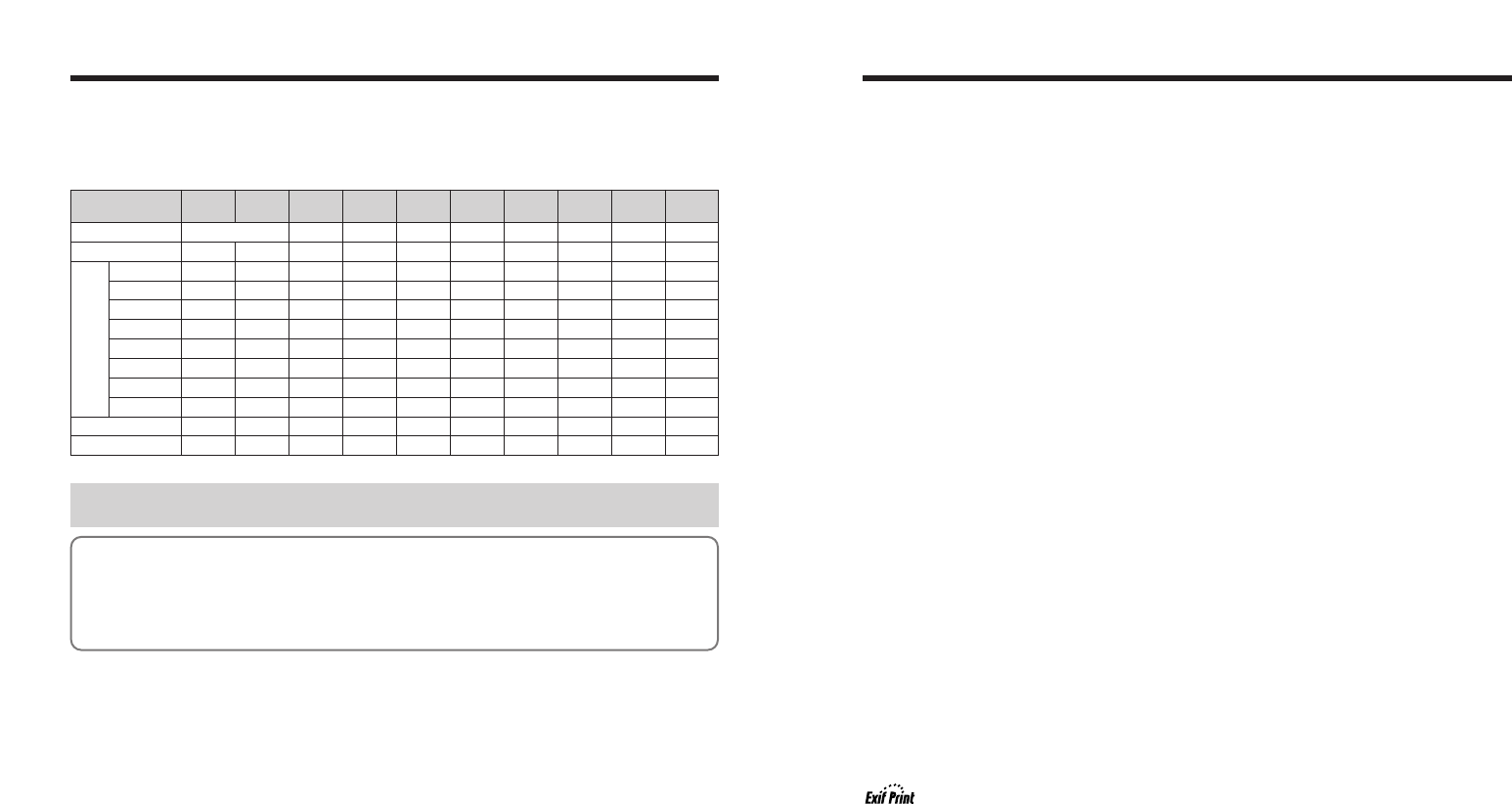
151
Explanation of Terms
Specifications
Deactivated batteries
Leaving an Ni-MH battery unused in storage for a long period may cause a rise in the level of substances that
inhibit current flow inside the battery and result in a dormant battery. A battery in this state is referred to as
deactivated.
Because current flow is inhibited in a deactivated Ni-MH battery, the battery’s original level of performance cannot
be achieved.
EV
A number denotes Exposure Value. The EV is determined by the brightness of the subject and sensitivity (speed)
of the film or CCD. The number is larger for bright subjects and smaller for dark subjects. As the brightness of the
subject changes, a digital camera maintains the amount of light hitting the CCD at a constant level by adjusting the
aperture and shutter speed.
When the amount of light striking the CCD doubles, the EV increases by 1. Likewise, when the light is halved, the
EV decreases by 1.
Frame rate (fps)
The frame rate refers to the number of images (frames) that are photographed or played back per second. For
example, when 10 frames are continuously photographed in a 1-second interval, the frame rate is expressed as 10
fps.
For reference, TV images are displayed at 30 fps (NTSC).
JPEG
Joint Photographic Experts Group
A file format used for compressing and saving color images. The higher the compression rate, the greater the loss
of quality in the decompressed (restored) image.
Memory effect
If an Ni-MH battery is repeatedly charged without first being fully discharged, its performance may drop below its
original level. This is referred to as the “memory effect”.
Motion JPEG
A type of AVI (Audio Video Interleave) file format that handles images and sound as a single file. Images in the file
are recorded in JPEG format. Motion JPEG can be played back by QuickTime 3.0 or later.
Smear
A phenomenon specific to CCDs whereby white streaks appear on the image when there is a very strong light
source, such as the sun or reflected sunlight, in the photography screen.
WAVE
A standard format used on Windows systems for saving audio data. WAVE files have the “.WAV” file extension and
the data can be saved in either compressed or uncompressed format. Uncompressed recording is used on this
camera.
WAVE files can be played back on a personal computer using the following software:
Windows: MediaPlayer
Macintosh: QuickTime Player
✽ QuickTime 3.0 or later
White Balance
Whatever the kind of the light, the human eye adapts to it so that a white object still looks white. On the other hand,
devices such as digital cameras see a white subject as white by first adjusting the color balance to suit the color of
the ambient light around the subject. This adjustment is called matching the white balance.
Exif Print Format is a newly revised digital camera file format that contains a variety of shooting information for
optimal printing.
150
✽ These specifications are subject to change without notice. FUJIFILM shall not be held liable for damages resulting
from errors in this Owner’s Manual.
✽ The LCD monitor on your digital camera is manufactured using advanced high-precision technology. Even so, small
bright points and anomalous colors (particularly around text) may appear on the monitor. These are normal display
characteristics and do not indicate a fault with the monitor. This phenomenon will not appear on the recorded image.
✽ The operation error may be caused in a digital camera by the strong radio interference (i. e. electric fields, static
electricity, line noise, etc.).
✽ Due to the nature of the lens, the edges of images may appear distorted. This is normal.
■ Standard number of available frames/recording time per media
The number of available
frames
, recording time or file size varies slightly depending on the subjects photographed. Note also
that the divergence between standard number of
frames
and the actual number of
frames
is greater for medias with higher
capacities. When used media is 4GB or more, a movie up to 60 minutes long (at the “
%
” setting) or 120 minutes long (at
the “
$
” setting) can be recorded.
Visit website for information on available Microdrive / CompactFlash card: http://www.fujifilm.com/products/digital/
✽ Number of recorded pixel is 4864 × 3648 when displaying images on PC by using FinePixViewer.
If you shoot using the xD-Picture Cards with model numbers containing “M” such as DPC-M1GB, movie recording time
may be reduced if you repeatedly record and erase (frame erase) image files. In such a case, erase all frames or format
the xD-Picture Card before use. Back up important frames (files) onto your PC or another media.
Quality setting
⁄
F
⁄
N
Number of recorded pixels
3488 × 2616
3696 × 2464 2592 × 1944 2048 × 1536
1600 × 1200
640 × 480
–
640
×
480
16 MB 3
6
28
56
6
13
56
113
32 MB
128 MB
256 MB
113 227512 MB
1 GB
228 456
Microdrive 340 MB 77
234
155
469
„
6
13
56
113
227
456
155
469
÷
12
25
102
204
409
819
279
842
3
19
40
162
325
651
1305
445
1313
2
25
50
204
409
818
1639
559
1642
`
122
247
997
1997
3993
7995
2729
8212
~
%
(30 fps)
0 13 sec.
Image data size
xD-Picture Card
4.5 MB 2.2 MB 2.2 MB 1.2 MB 780 KB 630 KB 130 KB 18.8 MB – –
1 27 sec.
13 2864 MB 28 50 81 101 497 3 55 sec.
6 111 sec.
13 223 sec.
27 7.4 min.
54 14.9 min.
18 5.1 min.
55 15.3 min.
320
×
240
$
(30 fps)
26 sec.
54 sec.
109 sec.
219 sec.
7.3 min.
14.6 min.
29.3 min.
2 GB
456 913 913 1640 2558 3198 15992 108 29.8 min. 58.6 min.
10.0 min.
30.1 min.Microdrive 1 GB
✽


















